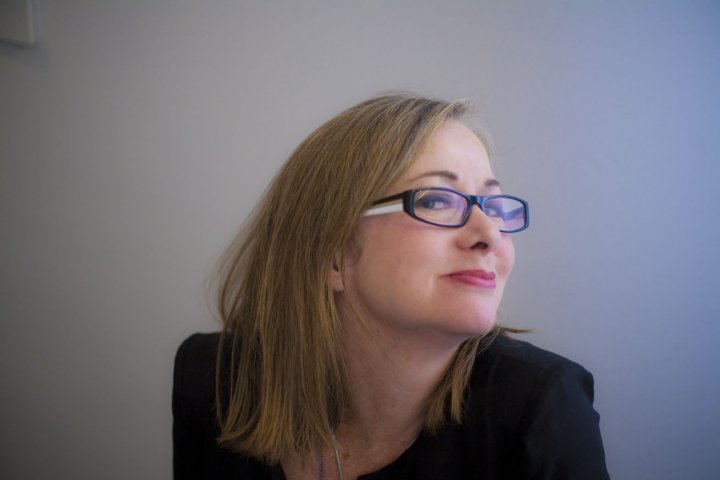
Robin Rule
Remembering Robin Rule, Denver Gallery Owner
Robin Rule, the passionate and complicated Denver gallery owner, died of cancer on December 29, 2013, age 55. Her indomitable spirit animated the Denver art world from 1987 to 2013, and her legacy will forever be tied up with the issues of the contemporary art world today in which complex loyalties and the difficulty of maintaining a business as a woman owner without patrons, backers or trust fund still apply.
Rule was born and raised in Kansas City. After earning a communications degree from Missouri State University in 1980, she moved to Denver and studied graphic design at the Art Institute of Colorado (formerly known as the Colorado Institute of Art).
Rule met Cydney Payton in 1985 and began doing graphic design work in 1987 from a desk in the office of Cydney Payton Artfolio (later Cydney Payton Gallery). It was here that she developed an interest in the gallery business. A partnership between the two women was formalized and, in 1990, Payton-Rule Gallery opened on Wazee Street.
Payton left the gallery to become the Director of the Boulder Museum of Contemporary Art in 1992. After several years on Wazee Street, Rule relaunched the business as Robin Rule Gallery at the Ice House in Denver and, in spite of innumerable challenges, kept the doors of her gallery open for more than 25 years in various locations including South Broadway and her final location in RiNo.
Her love for Denver artists put many of them on the map, including Dale Chisman, Margaret Neumann, Wes Kennedy, Mary Ehrin and Christine Buchsbaum, to name a few. Clark Richert, who started out at Cydney Payton Gallery, remained until Rule closed her gallery’s doors in February 2013. Rule’s last curatorial venture, “Dimension and Symmetry,” an exhibition of Richert’s work, is on view at the Gildar Gallery through January 18.
“It was hard for her to close her space,” artist Sarah McKenzie said recently. “Many times she kept her gallery going against all odds. Robin just made you feel that she really loved your work. She was so enthusiastic about the artists she represented. She was an art cheerleader. She didn’t show work just because she felt she could sell it.”
Every time I visited with Robin Rule at her gallery, it was her passionate belief in the exhibition and the work that always struck me. It was never a sales pitch with her; it was a deep discussion about the art. I will miss Robin’s infectious smile and our conversations.
Artist Pard Morrison said, “She had a tremendous eye and filled a niche, in Denver and regionally. She was almost experimental in the way she would try work out. If she liked your work she would take the ball and run with it.”
“Her contribution in my estimation was incalculable,” Bruce Price said. “She stayed current. She was interested in avant-garde and contemporary work. Yeah, there were the bread and butter artists that almost paid the bills, but she took risks too. She was interested in younger talent and made a point of including emerging artists and giving them a chance.”
Another aspect that was consistently mentioned was Rule’s ruthless honesty. Denver gadabout and owner of the Buffalo Exchange, Todd Colletti gave her the nickname “Clobber Rule.”
“One of her greatest attributes was how truthful she was,” Pard Morrison said. “She was brutally honest. To her credit, she wouldn’t string them along if she didn’t like their work. Some people were offended.”
Yet Rule herself was a complicated, distinctive soul, with her hip horn-rimmed glasses, waif-like figure and bobbed hair. Equally private and reserved, yet incredibly generous and warm, to some she may have seemed a dichotomy.
“I think she was easily hurt,” Bruce Price said. “She was not unaware of people’s opinions about her and all that kind of stuff. She was really generous. That’s the flip side. She was generous with the gallery, allowing people to use it for political and social reasons.”
She was also a big booster of Denver and Colorado, which was a defining characteristic of the legacy she leaves behind. She believed in the art that was being made here.
“Robin was devoted. She loved her city and believed her city should have a place for artists and social interaction,” curator Cydney Payton said. “She pushed in the face of reason. Her drive and commitment and sense of responsibility, to have a market in Colorado for national art that works anywhere, was a labor of love. She enjoyed trying to build a collector base and put a lot of effort into that and Denver Art Museum.”
Yet she was also disappointed in how easily the region could turn its back on art. “She kept believing,” photographer Mark Sink said. “She would get excited and tell me that the boat has come in, it’s finally happening — and then the boat would untie from the dock and pull away. We just kept thinking that Denver was going to wake up and it was going to happen.”
Many are still waiting for that day when there is a strong, multigenerational collector base and support for art in Colorado. It remains an emerging market. “Anybody that has a gallery in Denver is incredibly brave,” Payton said.
“Robin’s legacy is tied to my own,” Payton added. “The gallery was an important vehicle to promote Colorado artists, and the best of them too, which is subjective, I realize. But the spirit of the gallery as an open system, rather than a closed system, is her living legacy. That and her support for artists in a market that’s emerging and not very solid.”

Robin Rule. Image courtesy of Mark Sink
